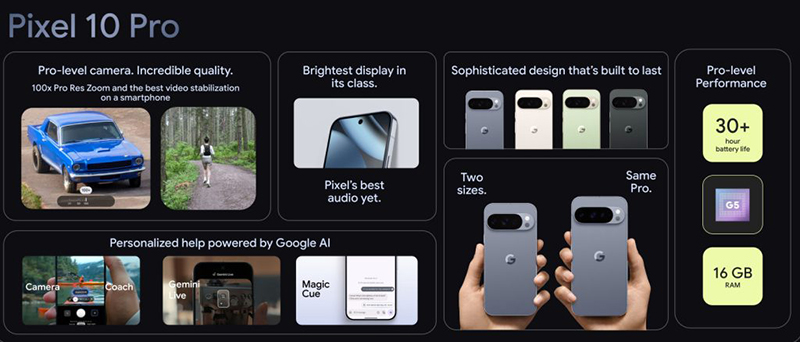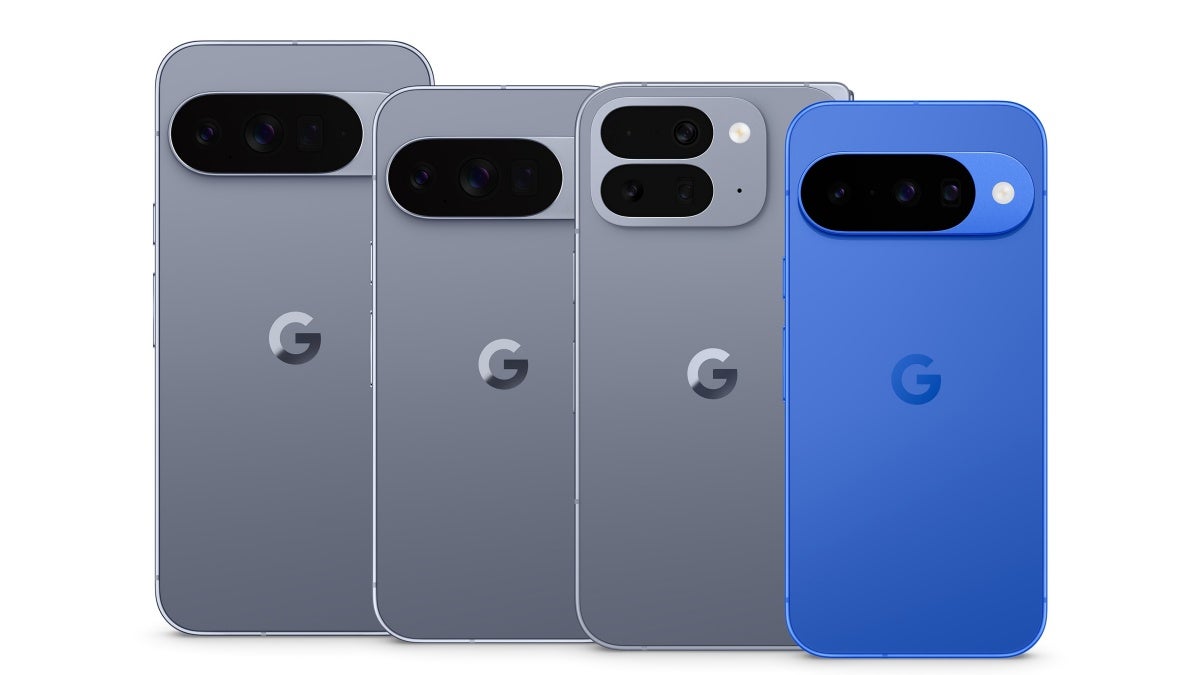The Google Pixel 10 series officially launched on August 20, 2025, during the Made by Google event. This year’s spotlight isn’t on a radical redesign or hardware leap, but on Google’s deep push into AI. The Pixel 10 lineup ships with tighter Gemini integration, one-year access to Google AI Pro, and the promise of a phone that feels more like a smart assistant than a device.
But as Apple and Samsung sharpened their flagships with features users yearnedfor, the question becomes: is the Pixel 10 really an upgrade you need—or just a testbed for Google’s AI ambitions?
A quick look at what Pixel 10 is offering
It’s still too early to measure the full market response to the Pixel 10 series, but the launch does show where Google wants to take its flagship. If you’re weighing an upgrade from an older Pixel or even considering a switch, the new features — along with some lingering concerns — are worth a closer look.
Key Specifications: Pixel 10, Pixel 10 Pro, Pixel 10 Pro XL, Pixel 10 Fold
| Specs | Pixel 10 | Pixel 10 Pro | Pixel 10 Pro XL | Pixel 10 Fold |
|---|---|---|---|---|
| Display | 6.3-inch Actua OLED (60-120Hz) | 6.3-inch Actua OLED (1-120Hz) | 6.3-inch Actua OLED (1-120Hz | 6.4-inch 120Hz 2364 x 1080 pixel resolution OLED Actua outer display, 8-inch 120Hz 2076 x 2152 pixel resolution OLED Super Actua Flex inner display |
| Processor | Tensor G5 | Tensor G5 | Tensor G5 | Tensor G5, Titan M2 security |
| Storage and RAM | 128GB-256GB, 12GB | 128GB-1TB, 16GB | 256GB-1TB, 16GB | 256GB-512GB, 16GB |
| Battery and Charging | 4,970mAH, 30W | 4,870mAH, | 5,200mAH, 45W USB-C, Wireless (Qi2.2-certified) up to 25W | 5,015mAH |
| Operating System | Android 16 | Android 16 | Android 16 | Android 16 |
| Camera | Selfie: 10.5MP, Rear: 48MP, Ultrawide: 13MP, 10.8, telephoto camera with 5x optical zoom + Super Res Zoom up to 20× | Selfie: 42MP, Rear: 50MP, Ultrawide: 48MP, 2.8, telephoto camera with 5x optical zoom | Selfie: 42MP, Rear: 50MP, Ultrawide: 48MP, Telephoto 2.8 48MP | Selfie: 10MP (Main Screen), 10MP (Cover Camera),Rear:48MP, Ultrawide: 10.5MP, Telephoto: 10.8MP |
| Launch Price | $799 / ₦1,233,560 | $999 / ₦1,542,336 | $1199 / ₦1,851,112 | $1799 / ₦2,777,440 |
What you may have missed from the table above:

1. No physical SIM slot
The Pixel 10 series ships without a SIM tray. It’s eSIM only. That sounds sleek, but it comes with baggage. Network coverage matters more than ever, since you can’t just swap SIMs on the go. Travellers will also need to confirm eSIM support before leaving the country. For anyone in areas where carriers are slow on eSIM, the Pixel 9 may feel like the safer option.
2. Bigger battery and smarter charging
Battery capacity has gone up across all Pixel 10 models, and the new G5 chip makes it more efficient. Faster charging and full Qi2 wireless support finally catch Google up to rivals like OnePlus. Still, the mandatory Battery Health Assistance feature is dividing users. It slows charging speeds over time to extend lifespan—good in theory, but some wish they had the choice to toggle it off.
3. Built-in Thread networking
For the first time on Android, Thread radios are inside the Pixel 10 series. Thread is a low-power mesh system backed by Google, Apple, Samsung, and Qualcomm. It makes smart home devices talk to each other faster and more reliably, without always needing a hub. Until now, Apple was the only phone maker shipping it. With Thread baked in, the Pixel 10 could quietly become the remote control for your smart home throughout Google’s promised seven years of software and security updates.
4. Cameras: one step forward, one step back
The base Pixel 10 finally gets a triple-camera setup, including a 5x telephoto lens. That makes it far more versatile than the Pixel 9. The trade-off is that Google has trimmed the main and ultra-wide sensors compared to last year’s flagship. The wide sensor drops to 48MP (down from 50MP), and the ultra-wide loses autofocus. On the flip side, Google’s improved image processing should deliver better low-light shots and smoother zoom. In short: more flexibility, but not always better optics.

Read Also: iPhone 16 Pro and Google Pixel 9 Pro face-off: Which compact Pro should you buy in 2025?
5. Modem upgrade
Pixels 6 and 7 were plagued by weak Exynos modems. Google claims the Pixel 10’s upgraded chip solves reception drops, overheating, and battery drain, especially in crowded cities. Heavy data users may notice the difference most, though some are still waiting for Google to ditch Exynos entirely.
6. AOD is smoother on Pixel 10
Outdoor visibility has been a pain point for years. Pixel 10 finally brings a brighter screen with faster refresh rates and sharper colours. The Pro models add a revamped Always-On Display that shows a blurred version of your wallpaper, similar to recent iPhones. Importantly, this is optional. You can stick with the minimal black AOD if you prefer.
7. Gemini AI everywhere
The headline feature is Gemini AI built into the system. Translation, transcription, and context-aware help are now more natural and more integrated. Some call it the first phone truly designed around AI. Others say it’s mostly hype, with software that doesn’t yet justify the leap. Biometrics also get a polish—the fingerprint sensor is quicker and face unlock is smoother, making daily use feel more fluid.

Should you upgrade?
If you’re still on a Pixel 6 or Pixel 7, you’ve likely experienced issues like weaker reception, dimmer display outdoors, shorter battery endurance, older fingerprint tech, or mid-tier modem performance. Those limitations make the leap to a newer Pixel worth considering.
That said, moving from your current device to a Pixel 10 isn’t a straightforward decision. What really matters is how the upgrades line up against your day-to-day use and the price you’ll pay for them. Two key areas to weigh are:
- The new features and improvements compared to your existing model.
- The overall cost of buying or upgrading to the Pixel 10.
Pixel 7 vs. Pixel 9 vs. Pixel 10
| Feature | Pixel 7 | Pixel 9 Series | Pixel 10 Series |
|---|---|---|---|
| Chipset | Tensor G2 (4 nm) with Titan M2 security | Tensor G4 (Titan M3) | Tensor G5 (Gemini Nano) |
| Display & Design | 6.3″ FHD+ OLED, 90 Hz, Gorilla Glass Victus, (1400 nits) peak brightness | Bright OLED (2.7k nits), Gorilla Glass | Even brighter “Actua/Super Actua” (3–3.3k nits), sleek matte frames |
| Cameras | 50 MP main + 12 MP ultrawide; Pro adds 48 MP telephoto 5× | 50 MP + ultra-wide ± telephoto (Pro) | Triple-lens on base; AI tools (Coach, Best Take), Pro Res Zoom, content credentials |
| Battery & Charging | ~4,355 mAh; 21W fast wired charging | ~4.4–5.2 Ah, up to 33 W wired, 25 W wireless | Slight increase; Qi2 wireless, reverse charging support |
| AI Features | AI like Photo Unblur, Guided Frame, Direct My Call | Gemini Live, Circle to Search, Smart Reply, Live Translate | Expanded suite: Magic Cue, Voice Translate (voice mimic), NotebookLM enhancements, etc. |
| Software | Android 13, 5 years of security updates | Android 15, 7 years updates | Android 16 with Material 3 Expressive, 7 years updates |
How much does Pixel 10 cost?
| Model | Starting Price | Available Colours |
|---|---|---|
| Pixel 10 Pro Fold | $1799 | Moonstone, Jade |
| Pixel 10 Pro XL | $1199 | Moonstone, Jade, Porcelain, Obsidian |
| Pixel 10 Pro | $999 | Moonstone, Jade, Porcelain, Obsidian |
| Pixel 10 | $799 | Indigo, Frost, Lemongrass, Obsidian |
On Google’s official store, the Pixel 10 lineup launches at familiar flagship prices with a few new colourways. The Pixel 10 Pro Fold sits at $1799, available in Moonstone and Jade. The Pixel 10 Pro starts at $999, while the larger Pixel 10 Pro XL begins at $1199, both sold in Moonstone, Jade, Porcelain, and Obsidian. The base Pixel 10 opens at $799, with Indigo, Frost, Lemongrass, and Obsidian finishes.
Meanwhile, the Pixel 9 series remains unchanged on the Google Store, softening the upgrade push for many. The Pixel 9 Pro Fold is still $1799 in Obsidian and Porcelain. Both the Pixel 9 Pro and Pixel 9 Pro XL start at $999—though there’s a $200 gap compared to the new 10 Pro XL. Their colour set includes Porcelain, Rose Quartz, Hazel, and Obsidian.
The Pixel 9 starts at $799 in Peony, Wintergreen, Porcelain, and Obsidian, while the more affordable Pixel 9a continues at $499 in Peony, Iris, Porcelain, and Obsidian.
To wrap up
Upgrading often comes down to timing. Trade-ins and promos can make new Pixels surprisingly affordable, but their value fades quickly while prices climb. The Pixel 10 shows Google pushing harder into AI, with upgrades in performance, charging, and cameras that make even the base model feel flagship-ready.
For those chasing the latest features, the Pixel 10 lineup is hard to ignore, but skipping a generation may still be the smarter move for many. Pre-orders are live now, with general availability on August 28, 2025.
Get passive updates on African tech & startups
View and choose the stories to interact with on our WhatsApp Channel
Explore




